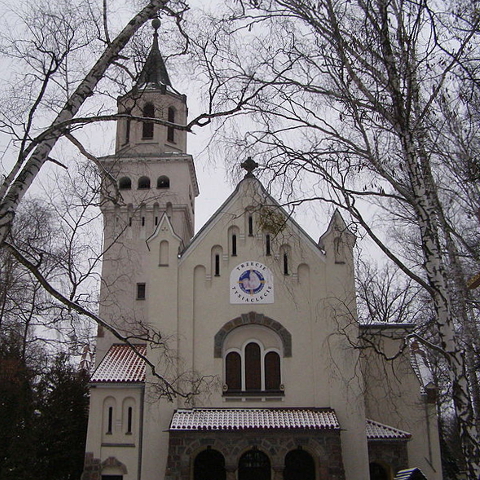Composers / Fryderyk Chopin / Places catalog
Presbytery of St Jadwiga (Hedwig) parish church in Milanówek
Milanówek is about 30 km south-west of Warsaw and is now part of its urban agglomeration. The town has been a summer resort for the more prosperous citizens of the capital from the very outset (the turn of the twentieth century). Milanówek is connected with Chopin in a very peculiar way.
When Chopin died, on 17 October 1849, his elder sister Ludwika brought his heart back to Warsaw, in accordance with his wishes. For a time, the heart was kept in a casket at her home on ul. Podwale. It was then placed in the crypt of Holy Cross Church in Warsaw sometime prior to 1861 and immured in the pillar on the left (as you walk up the main aisle) on 28 February 1880. Here it stayed until the Second World War (1939–1945).
When the Warsaw Uprising broke out, on 1 August 1944, Holy Cross Church was under German control. The Germans, realising that the church might be completely destroyed in the fighting, decided to protect the casket containing Chopin’s heart. During the war, the presbytery of St Jadwiga (Hedwig) parish church in Milanówek was also the office of Warsaw Metropolitan Curia. The Germans sent a delegation to Abp Antoni Szlagowski, as they wanted to transfer Chopin’s heart to the ecclesiastical jurisdiction. In a report for the Fryderyk Chopin Society written many years later, the eminent Chopin scholar Bronisław Edward Sydow, who lived in Milanówek at the time, wrote: ‘Two officers were despatched [by SS General Erich von dem Bach-Zelewski, commander of the German forces charged with suppressing the Warsaw Uprising] by car to Milanówek on the morning of 9 September with a summons for Abp Antoni Szlagowski, who resided in the presbytery and was responsible for the churches of Warsaw, to return to Warsaw with them’.
The presentation of the heart to Abp Szlagowski in front of the cameras on 9 September 1944 was a propaganda exercise on the part of the Germans. The casket, now safe and secure, awaited the end of the war. Although Abp Szlagowski kept it on the piano in his private chapel on the first floor of the presbytery, it did not stay there the entire time, but was given to trusted parishioners for safekeeping. This priceless national treasure obviously had to be returned to Warsaw after the war. Sydow examined the casket before it was handed over and noted his observations in a report: ‘the casket consists of an outer oaken box with a second, mahogany, box inside. On the lid is a heart-shaped silver plate inscribed with the dates of Fryderyk Chopin’s birth and death. Inside the box is a hermetically sealed crystal urn with Chopin’s heart perfectly preserved in clear alcohol’.
On the ninety-sixth anniversary of Chopin’s death, 17 October 1945, Revd Leopold Pietrzyk, parish priest of the Church of the Holy Cross in Warsaw, together with Professor Bolesław Woytowicz and Bronisław Sydow, received the urn from the archbishop, who said: ‘A year ago, I removed this heart of a great Pole from the burning Warsaw, and for the whole year I was the guardian of this national treasure. Today, I hand it over to you. Venerable father, rector of the Church of the Holy Cross in Warsaw, return it to its place. May this august deposit on a better future again represent the lofty flights of the capital city. May it be a symbol of the inextinguishable spirit of our nation.’
The casket was then brought to Żelazowa Wola, by way of Grodzisk and Błonie, where a state celebration was held. This was exploited for propaganda purposes by the communist authorities. The Mayor of Warsaw, Stanisław Tołwiński, handed the heart to a delegation of students from the Warsaw Conservatory and the Warsaw School of Music. Bolesław Bierut, leader of the ‘People’s Poland’, was present, and Henryk Sztompka gave a recital. Once the heart had arrived in Warsaw, Fr Leopold Pietrzyk celebrated a mass in the Holy Cross church. Fr Prof. Hieronim Feicht gave the sermon.
There is a plaque on the wall of the presbytery in Milanówek commemorating the fact that Chopin’s heart was kept there. A bust of the composer, sculpted by Janusz Tomasiński, was installed between the presbytery and the church on the initiative of Milanówek Cultural Society.
-

Saint Hedwig of Silesia Church in Milanówek. Phot. Ewa Dryjanska.